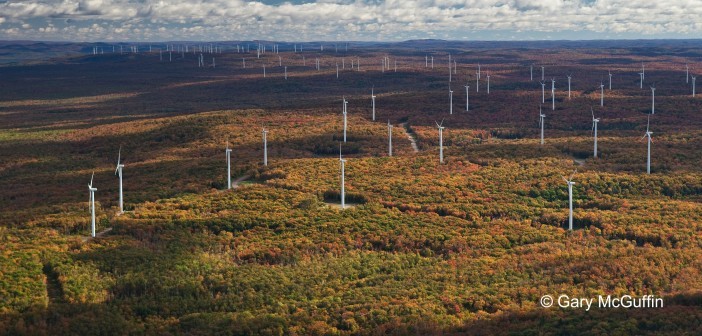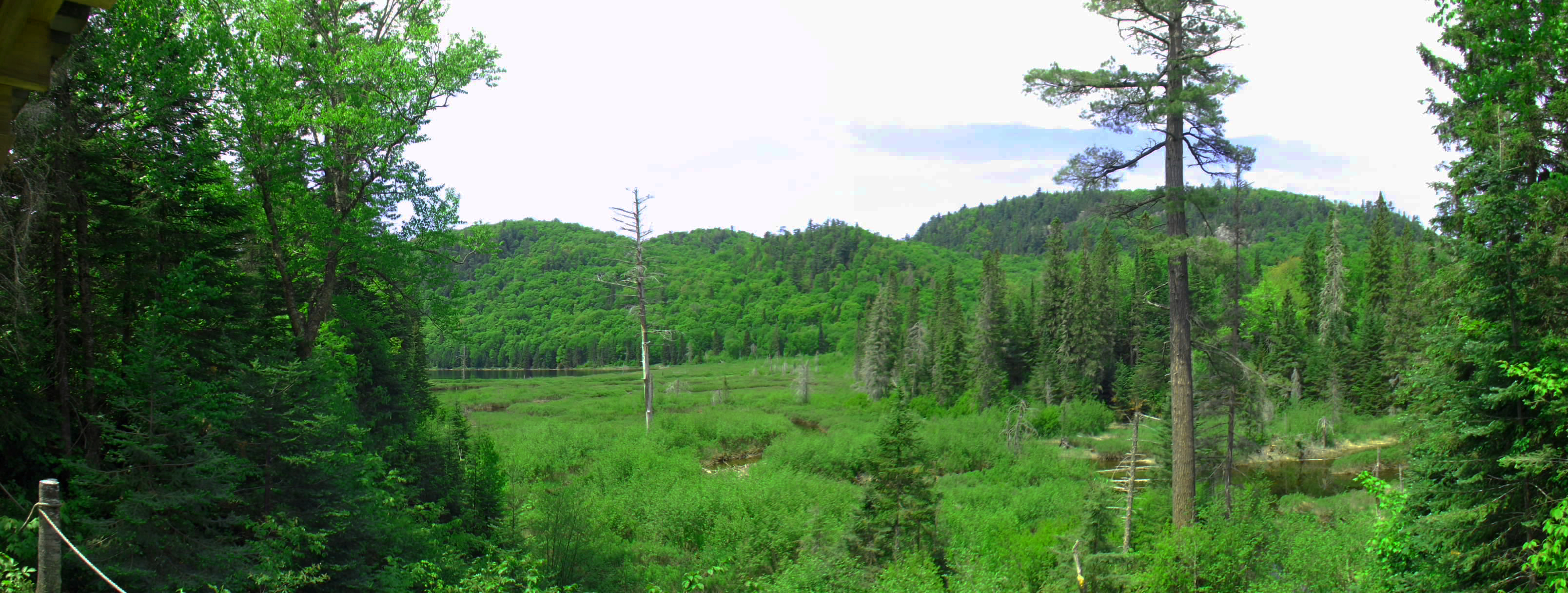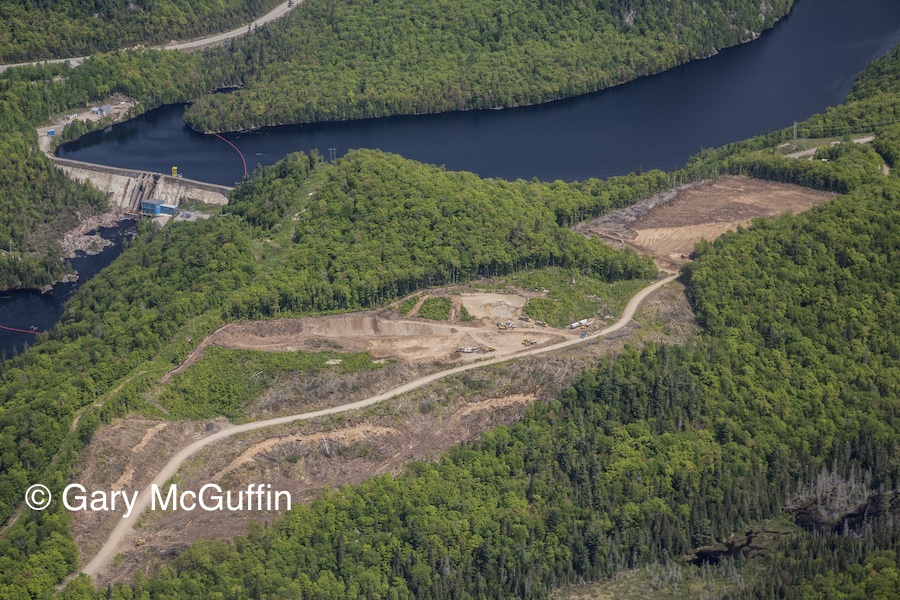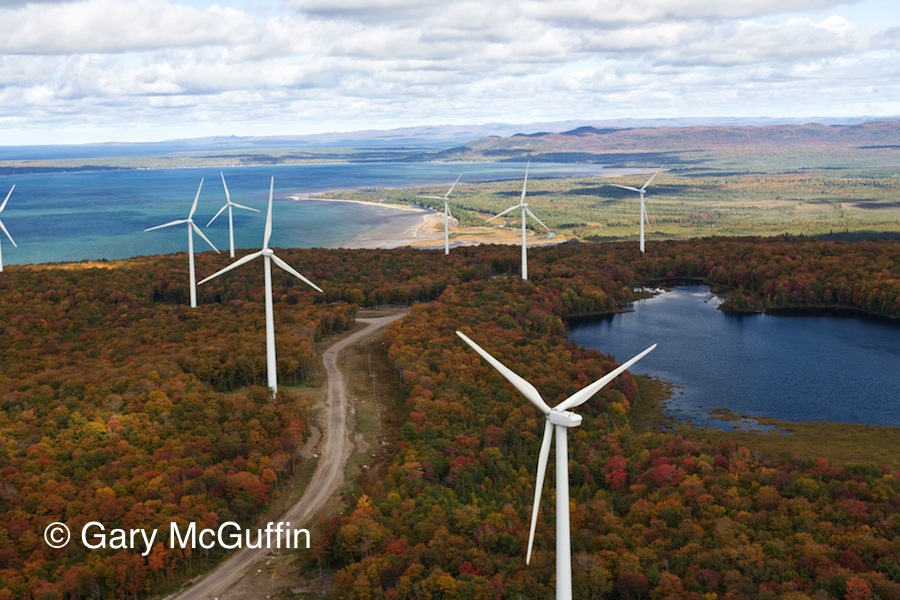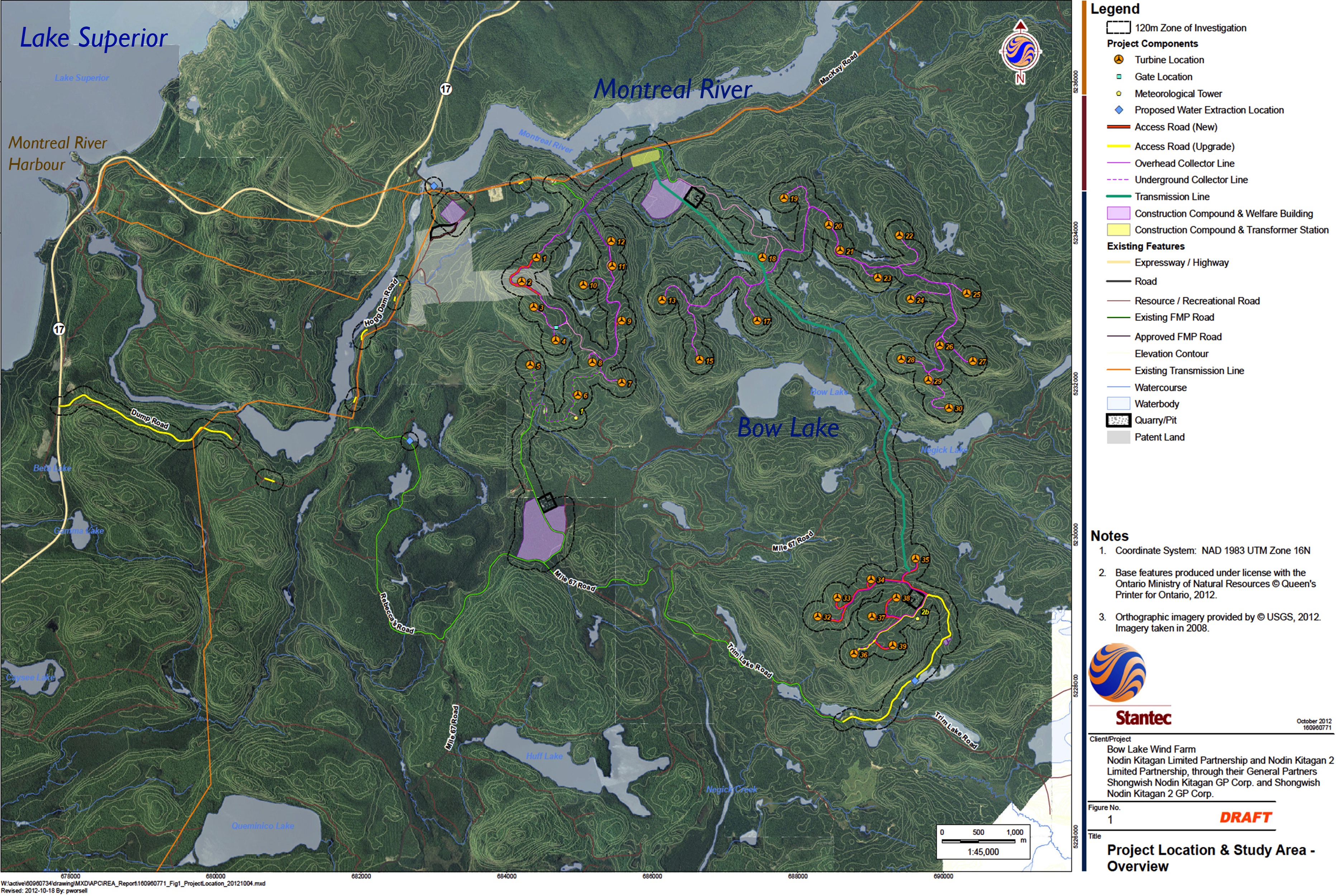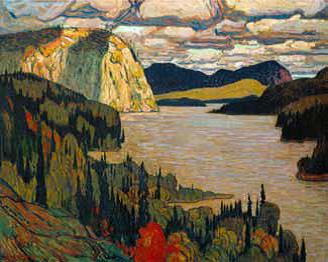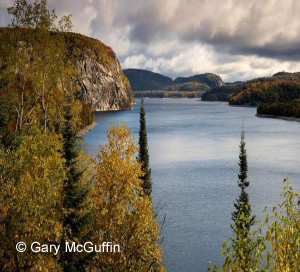Aerial photography by Gary McGuffin
“I cry about losing this.” Jim Fata is seated on his front deck looking across Negik Lake and the lush mountainous ridge beyond it.
The canopy of trees above him is busy with vocal birds, even a tiny hummingbird takes a rare break on a slender branch of a nearby maple tree to say a few things, and the bush around him is lively as small creatures go about their foraging and hunting business.
Jim first came to his little piece of heaven in 1994. He and his wife, Marion, were excited and anticipated the wonderful memories that would be created there with their two boys. Marion would only visit Negik Lake once before she passed away. It is a day that Jim cherishes. And it was a day that connected him deeply to that land.
Jim’s front yard, Nejik Lake.
On July 9th, 2014, the appeals of James Fata and 2401339 Ontario Ltd. heard by an Environmental Review Tribunal (ERT) on the matter of objecting to a proposed 36 turbine industrial wind farm on Bow Lake were dismissed. Jim’s appeal was with concern to serious harm to health and the 240 company focused their concern on the irreversible harm to the environment- little brown bats and birds, and safety- the impact of wind turbines on the Montreal River Radar Station. The ERT determined that neither appellant presented enough evidence to support their positions. That decision can be read in full on the ERT website.Bow Lake is located about 80 clicks northwest of Sault Ste. Marie. The wind farm project has been sited along the eastern edge of Lake Superior and south of the Montreal River. The project is within the sight line of Nejik Lake residents. The Bow Lake setbacks satisfy government regulation of 500 meters or greater but for the appellants and participants in the Bow Lake appeal industrial wind turbines can never be set far enough back.
George Browne is a member of Lake Superior Action Research Conservation (LSARC). LSARC is a grassroots collective of individuals who share a common interest in conservation and preserving the Eastern shore of Lake Superior from industrialization. George was also the appellant on behalf of the 240 company. “This is not a matter of us not wanting these wind projects in our backyard. We don’t think they belong in anybody’s backyard.”
Lake Superior. Montreal River Weather Radar Station, upper right corner. Foreground, ridge where wind turbines will be places for Bow Lake Wind Farm.
In Ontario there have been 20 appeals in opposition to industrial wind turbine farms brought before the Ministry of the Environment (MOE) and 19 have been dismissed. An appeal by Prince Edward County Field Naturalists to kill the development of an industrial wind turbine farm on Ostrander Point was won before an ERT in July 2013. However, the decision has since been reversed by the Ontario Divisional Court and appellants are seeking an appeal before the Ontario Court of Appeal.
George commented, “The 240 Bow Lake appeal came close to winning. Based on the Ostrander Judicial Review decision the Tribunal found that in order to prove irreversible harm it was necessary for the appellant to know the size of the populations being harmed. Having found that the 240 appeal failed to prove irreversible harm the Tribunal declined to make a finding on the issue of serious harm, though it agreed with virtually all the arguments on bats submitted by the 240 appeal.
As a result the Tribunal imposed immediate and more stringent mitigation measures on the project – a tacit admission that species-at-risk bats would otherwise be killed, which would be a serious harm.
The Tribunal’s decision is peculiar in that it allows these more stringent mitigation measures to be rescinded should they prove effective. Had the MNR required, or done, a baseline study, or had the 240 appeal had the time and money to do one, to determine the size of existing bat species populations in the project area, we would perhaps have had the final piece of the puzzle required to win.”
Montreal Dam. Construction for Bow Lake Wind Farm in process, Spring 2014.
In 2006 the Prince Township Wind Farm was completed with 126 wind turbines installed. The Goulais wind farm hosts 11 turbines and the Bow Lake project will erect 36 turbines over three phases of development. There are twenty-one additional sites throughout Northern Ontario that have been targeted for wind projects by the Ministry of Natural Resources. A map of the proposed sites can be found on the LSARC website.
For individuals like Jim, and small citizen groups like the 240 company, the challenges are stacked. Jim could not afford a lawyer and the 240 company was able to provide resources for only one lawyer. The approval holder, BluEarth, hired four lawyers each one tasked with specific areas of the appeal. In addition, two lawyers as well as one assistant provided counsel on behalf of the Ministry of Environment.
Over $300,000 in legal fees was incurred by the 240 company in the Bow Lake review. Ninety-five percent of that amount was covered by an anonymous donor and the remaining 5% came from members of LSARC and Save Ontario’s Algoma Region (SOAR). SOAR is a grassroots organization in the Algoma region that is committed to the preservation of the natural environment.
In addition to the obvious disparity of financial resources so is the fact of the extreme variance of responsibility between parties. The burden of onus to prove serious harm to human health and irreversible harm to the environment is placed upon the appellant. However, the approval holder does not have to prove that serious harm to human health and irreversible harm to the environment does not exist.
Referring to the 240 company’s obligation to prove irreversible harm to the little brown bat and birds George remarked, “It is an ironic quirk of the Ontario Judicial system and the Judicial Review’s decision that in order to prove irreversible harm an appellant is required to know the size of the species’ population, but in order to affirm that the same level of mortality is safe, the MNR and the Approval Holder don’t need that information.”
Jim shakes his head as he recalls his experience during the ERT hearing. “One of the lawyers for the developers said to me ‘well you’re use to noise aren’t you? Because there’s logging going on there.’ Well you know the odd time that I’m up here I can hear a logging truck go by or hear them logging. That’s fine. When nighttime comes I don’t hear anything. I might hear it the next day or for a few more days until they are finished logging but then the job is done and it’s quiet again. These wind turbines are forever.”
Tens of thousands acres cleared to move in parts for IWT’s. A close up shot of the wood left behind. Spring 2014.
Days before accepting the office of Premier, Kathleen Wynne remarked that the government would not force industrial wind turbine development upon municipalities that were an unwilling host. Since that announcement approximately 85 municipalities in Ontario have self-declared as ‘Unwilling Hosts’.
For people living between Sault Ste. Marie and Wawa Wynne’s public statement does not bear impact. Gillan Richards lives in Goulais River. She is a representative of SOAR and was a participant on behalf of the group in the Bow Lake ERT. Gillan focused her concerns to the matter of the impact of wind turbines on human health.
Gillan commented, “Between Sault Ste. Marie and Wawa there is no municipality. It is all unorganized territory. That means that those of us who live here do not have any political representation as a municipality. We do not have a municipality that can declare that we are not a willing host.”
It is only small private citizen groups like SOAR and Lake Superior Action Research (LSARC) or individuals owning property in unorganized territory that can come forward and make a statement. “We are recognized before the ERT as being a voice of the people,” commented Gillan of the situation. “But we are not the municipal voice of the people.”
Gillan’s frustration with the ERT process was amplified when just days after presentations to the ERT wrapped up, a report was released by Dr. Alec Salt, that took the position that human health can be affected by the low frequency and infrasound produced by industrial wind turbines. Gillan submitted the report as evidence in her final statement to the ERT but it was rejected on the grounds that the information was not addressed in her participant presentation.
Perhaps adding insult to injury in the ERT’s dismissal of the Bow Lake appeal is that the industrial wind turbines to be erected in Northern Ontario are already out-of-date technology.
Saphon Energy specializes in the research and development of wind technology. The cleantech company developed a bladeless wind turbine – a significant contribution to wind technology because it eliminates the human health affects created by low frequency and infrasound produced by spinning blades and reduces harm to bats and birds. Claims that the bladeless technology is more efficient and less expensive are attributed to energy production not reliant upon large moving parts.
Prince Wind Farm.
During appeal preparations, Jim gathered together five individuals to present before the ERT as expert witnesses. Three of those witnesses were expert in the area of tourism- a focus established by the ERT as out of scope of the review and as such denied any status at the hearing. The remaining two individuals were accepted as experts in their field- social work and nursing, but were not accepted as experts in the area of industrial wind turbines or the impact of wind turbines on human health. However, they were granted participant status. “I was losing at every turn before I even got out of the gate,” said Jim of the process. “This is my retreat. This is where I come to get in touch with nature. This is as close as you’re going to get to God’s country and people shouldn’t destroy it. This is for all of us to enjoy. Not just some guys that are going to shove a bunch of steel poles into the mountain and make a bunch of money and then take off.”
In a chapter from the Ontario Wind Performance journal it is explained that energy produced in Ontario is stored on one grid whether it is produced from coal, hydro or wind. When the grid is overloaded energy is exported. Knowing what electron of energy came from what source is impossible to know but energy generation can be paralleled alongside energy export from the grid. What is observed is that when there is a spike in wind production there is also a spike in the exportation of energy from the grid. Ontario does not have the ability to store surplus energy once the grid reaches full capacity. When the grid is overloaded energy must be exported. Exported energy from Ontario is sold to Quebec or the U.S.A for almost a third of the cost to produce wind energy.
Below is the site map for the Bow Lake Wind Farm. Each orange dot represents an IWT.
“One of the lawyers asked me ‘what I wanted’. Can you believe that? I told him I wanted it to be the way it is. Leave it alone. I don’t want an invasion of industrial wind turbines in the bush. That’s why I come out to the bush. I want to get away from the city life.”
Jim is your typical man’s man and one of few words. But he has plenty to say about his love for the wilds of Northern Ontario. “I’ve seen the Northern Lights here at night time. And I see them because there is an absence of artificial light. It’s so dark here at night. I can’t see my hand in front of my face in the middle of the night when I get up to go the bathroom. Those turbines have red, flashing lights on the blades. We won’t have those dark night skies anymore.”
Jim turn’s his ahead away from the landscape, taking a moment to steady himself. When he refocuses his gaze across Nejik Lake his cheek is wet from one tear that made it past his tightly squeezed eyes.
“They’re going to destroy a heritage coast that is known throughout the world. Can you believe that anybody is going to do that? There’s hardly any places in the world left like this. The cumulative effect is going to be like dominoes. There will be wind turbines from here all the way down to Thunder Bay.”
Many opponents of the installation of industrial wind turbine projects express that, especially in Northern Ontario, there is a devastating loss to the natural landscape. It is a viewpoint that Joanie and Gary McGuffin are passionate about. The couple has actively dedicated a lifetime to the conservation, study and education of our precious water resources and our magnificent northern landscape. Joanie spoke as a participant at the Bow Lake ERT.
With consideration to the limited scope of the review that narrowly focused on irreversible harm to the environment- bats and birds, and serious harm to human health- specifically low frequency noise and infrasound, Joanie expressed frustration. “There is a social, ecological and economic impact associated with these turbines. When you consider that ecotourism could be a very important contribution to the economy and the well-being of so many people that live here it is absurd that it was not given significant weight in the review. ”
The World Conservation Union defines ecotourism as, “Environmentally responsible travel to natural areas, in order to enjoy and appreciate nature (and accompanying cultural features, both past and present) that promote conservation, have a low visitor impact and provide for beneficially active socio-economic involvement of local peoples.”
Seven years ago, Gary and Joanie, accompanied by their colleague, Michael Burtch, set out into the untamed territory of the Algoma district in search of the sites where the internationally renowned Group of Seven painted. To date the trio has located, and Gary has photographed, over 400 spots where the Group painted.
“We did this just for the love of it,” said Gary. “All of these sites will be marred by the installation of wind turbines. These turbines are over 400 feet tall and they are set on the highest ridges in the region.”
The Solemn Land, J.E.H MacDonald Present day, photographed by Gary McGuffin
In a report published by Ontario Cultural and Heritage Toursim it is stated that, “It has been proven globally that arts, culture and heritage are key ‘destination enhancers’ –i.e., they play a significant role in determining the overall desirability of a particular destination, whether or not these are cited specifically as reasons for travel.”
The same report also states that, “…culture can be the main reason to travel -without which visitors would not travel to a particular destination. In this instance, culture becomes the destination motivator and we view this as cultural tourism. Cultural tourists tend to be motivated by ‘learning something new’, ‘hoping to enrich their lives through their travel experience’s and ‘education and enrichment’.”
Speaking of the pristine Algoma region Joanie stated, “Culture and heritage tourism is a valuable and fast growing form of tourism. People come from all over the world to experience the Algoma region but we haven’t capitalized on this to the extent that we could be. This story about the Group of Seven is worth something economically to the City of Sault Ste. Marie and the entire region. But at the core of it all for tourism -winter, summer, spring and fall, is a landscape that is unique on this planet.”
“I didn’t think that I was going to win this thing.” Jim crosses his arms across his chest and sets his jaw. He’s still focusing across Nejik Lake, across the unbroken landscape. “I knew the chances were slim to nothing. But I knew too that if I didn’t try to do something then it would be like saying that I thought it was ok that it was happening. And it isn’t ok.”

